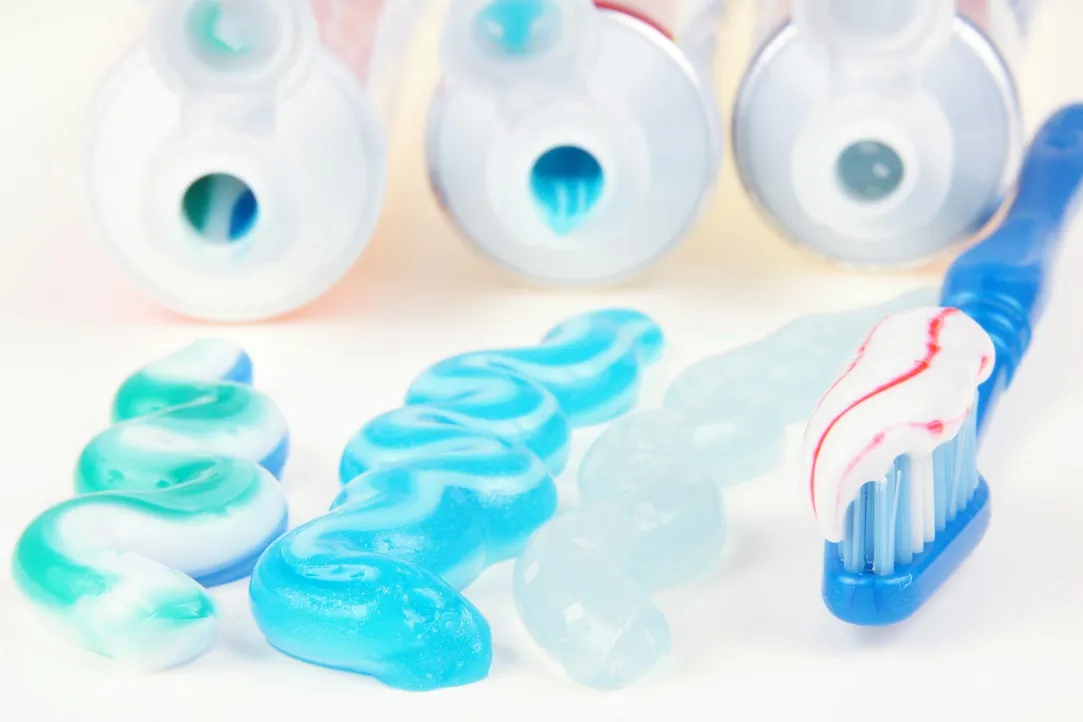
Certains des ingrédients contenus dans les dentifrices populaires peuvent être mauvais pour la santé.
Utilisez-vous du dentifrice tous les jours ? Bien sûr, vous en utilisez ! Mais savez-vous ce que contient ce tube de gel dentaire à la menthe ? Voici la réalité. Certains ingrédients des produits courants n’ont pas été testés de manière approfondie.
Le dentifrice étant un produit de base dans votre salle de bains, il est important de savoir ce que vous mettez dans votre bouche, puisque vous l’utilisez si souvent. Cela est particulièrement vrai si vous avez des enfants, car ceux-ci sont plus susceptibles d’avaler du dentifrice.
Alors, lorsque vous achetez un dentifrice, quels sont les ingrédients à éviter ?
Les colorants artificiels
Les colorants présents dans le dentifrice donnent un aspect coloré à celui que vous mettez sur votre brosse à dents, mais cela ne les rend pas sains. Certains colorants sont dérivés du pétrole ou du goudron de houille, des ingrédients liés à certains types de cancer. Qui sait quels sont les risques pour la santé si vous en avalez de petites quantités chaque jour ? Pourquoi prendre ce risque alors qu’il existe des dentifrices qui ne contiennent ni colorants ni teintures artificielles ?
Pour éviter les colorants artificiels, recherchez des colorants naturels, comme la poudre de jus de betterave ou la poudre de curcuma, au lieu d’utiliser ces produits chimiques. Pour savoir si votre dentifrice contient des colorants artificiels, vérifiez la liste des ingrédients pour ces noms communs : FD&C ou D&C suivi d’une couleur et d’un numéro (par exemple, FD&C Red No. 40), Blue 1 et 2, Green 3, Orange B, Citrus Red 2, Violet 2). Heureusement, il existe des dentifrices qui ne contiennent pas ces colorants, disponibles en ligne et dans certains marchés d’aliments naturels et magasins d’aliments naturels.

Certains dentifrices contiennent des colorants artificiels. S’ils rendent le dentifrice plus joli, ils ne constituent pas forcément un choix sain.
Diéthanolamine (DEA)
La diéthanolamine (DEA) est un produit chimique utilisé dans de nombreux produits, dont le dentifrice. Il s’agit d’un dérivé pétrochimique qui est parfois ajouté aux produits en tant qu’agent tensioactif, émulsifiant, agent moussant et épaississant. On le trouve également dans les cosmétiques, les shampooings et les savons. Dans le dentifrice, il aide à prévenir l’accumulation de tartre et à réduire la plaque dentaire, mais il présente certains inconvénients.
L’American Dental Association (ADA) suggère également d’éviter les dentifrices contenant de la DEA, car elle peut réagir avec d’autres ingrédients pour former des nitrosamines, qui sont toxiques pour les humains. Il est possible que la diéthanolamine (DEA) ait des effets cancérigènes et provoque des réactions allergiques, en particulier chez les personnes souffrant de certains problèmes de santé. En outre, on craint qu’elle ne soit un perturbateur hormonal.
Sulfate de Laurel de Sodium (SLS)
Sodium lauryl sulfate (SLS) is a surfactant, which is a compound that helps water and oil mix. It’s also used as a foaming agent in some personal care products, including toothpaste, shampoo, and soap.
SLS has been the focus of many studies that have linked it to skin irritation and other health problems — but it’s still considered safe by the FDA, because no scientific study has clearly found that SLS causes cancer or other serious illnesses. However, these two ingredients have been linked to canker sores and other mouth irritations, so it’s best to avoid them if you can.

You have many different options when buying toothpaste, so look for ones that do not have potentially unhealthy ingredients.
Triclosan
Triclosan is an antibacterial and antifungal agent that was once a common additive to toothpaste. It’s also a hormone disruptor and a registered pesticide that causes infertility and other issues in animals.
There’s also evidence that triclosan disrupts the gut microbiome, the healthy bacteria that live in your gut and help maintain balance. The Food and Drug Administration banned triclosan in antibacterial soaps in 2016 and in toothpaste in 2019. However, if you stocked up on toothpaste and still have older tubes lying around, they may contain triclosan.
There’s another reason to avoid triclosan. According to the American Dental Association (ADA), triclosan can cause inflammation of the gums and tongue, and alter your mouth’s pH level, which will lead to increased sensitivity and dryness.
Titanium oxide
Titanium dioxide is a common ingredient in toothpaste. It’s used to whiten teeth and reduce tartar build-up, but it can also irritate your teeth and gums. It’s also an ingredient in sunscreen and paint.
If you have sensitive teeth, avoid products that contain titanium dioxide, also known as titania. Although there’s no evidence that small amounts of titanium dioxide cause harm, there’s some debate over how safe it is. It’s most problematic if you have sensitive teeth.
Artificial Sweeteners
Although a strong link between artificial sweeteners and cancer has not been proven, studies suggest artificial sweeteners may disrupt the gut microbiome. So even though they may make toothpaste taste nice, it’s best to avoid them in foods and toothpaste.
Conclusion
There are many brands that use questionable ingredients. And while you may think, “But I brush my teeth so quickly, how could these really impact me?” The reality is that if you brush every day with a toothpaste containing questionable ingredients, it could harm your health, and there are concerns about children using them too. There are plenty of natural products that can have the same cleaning effects as their chemical counterparts. So next time you shop for toothpaste, read those labels and pick one with only safe ingredients!
References:
- “Artificial Sweeteners Study – Medical College of Wisconsin.” 26 Jun. 2019, .mcw.edu/newsroom/news-articles/artificial-sweeteners-study.
- Yueh MF, Tukey RH. Triclosan: A Widespread Environmental Toxicant with Many Biological Effects. Annu Rev Pharmacol Toxicol. 2016;56:251-72. doi: 10.1146/annurev-pharmtox-010715-103417. PMID: 26738475; PMCID: PMC4774862.
- “Coal Tar and Coal-Tar Pitch – Cancer-Causing Substances – NCI.” .cancer.gov/about-cancer/causes-prevention/risk/substances/coal-tar.
- CampaignforSafeCosmetics.org. “Nitrosamines”



